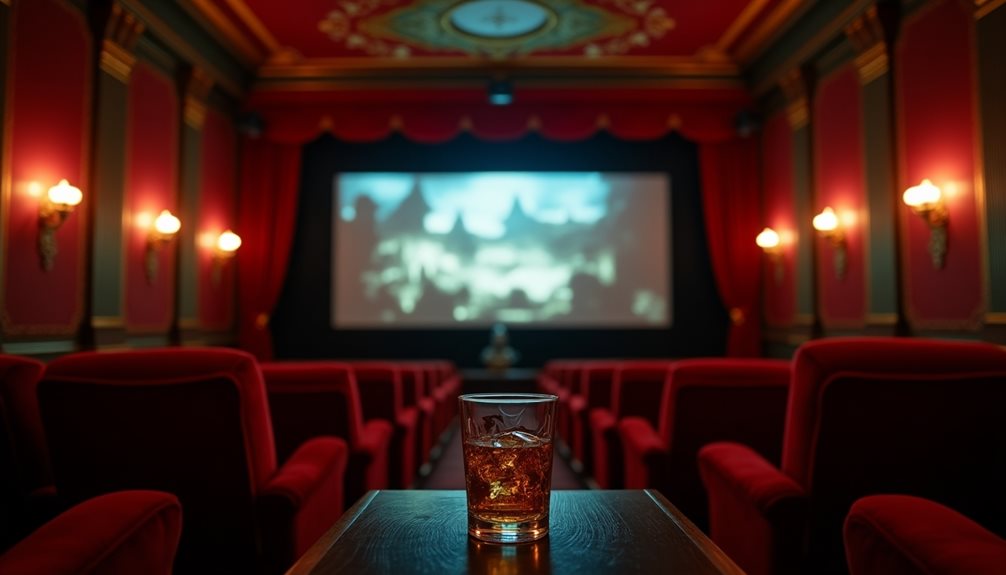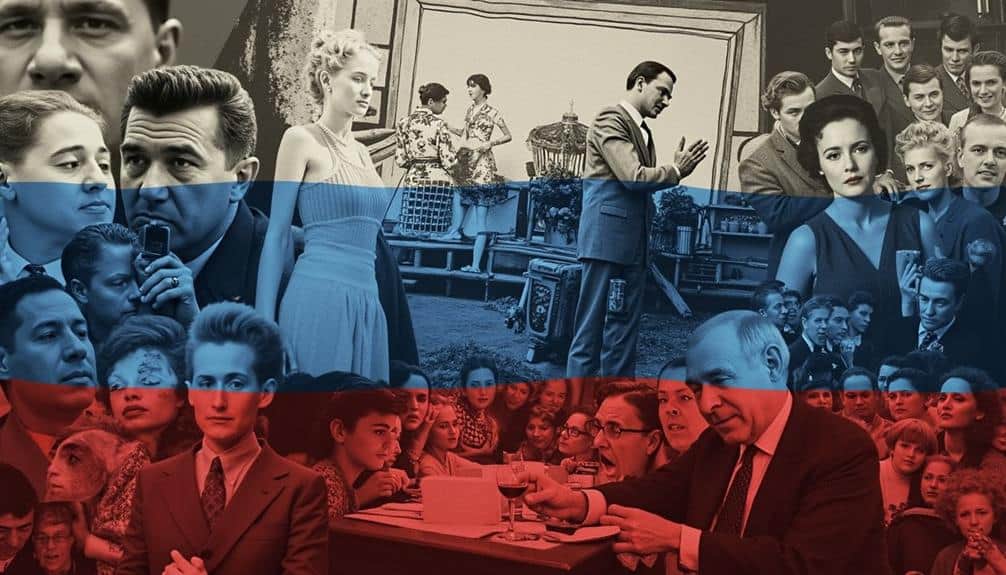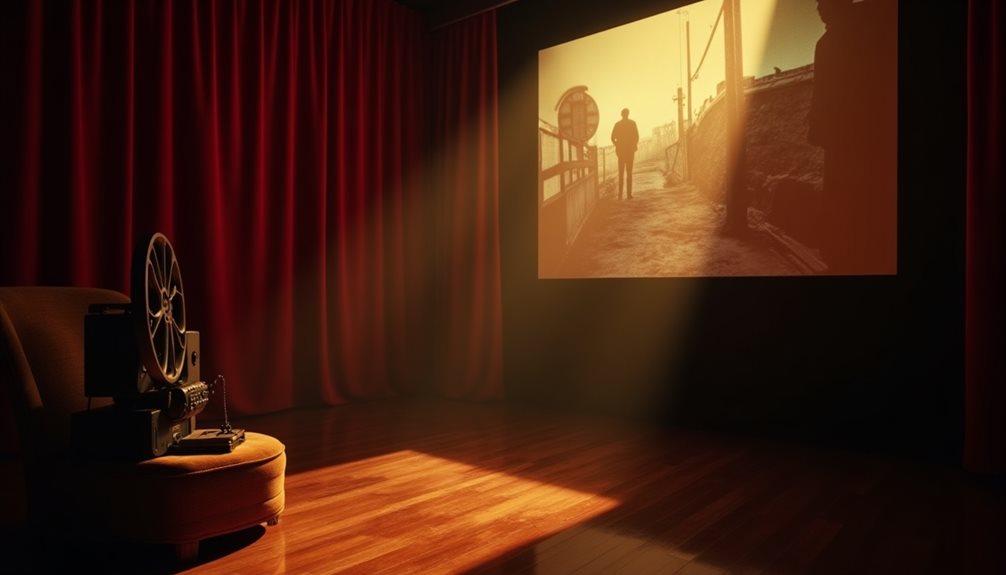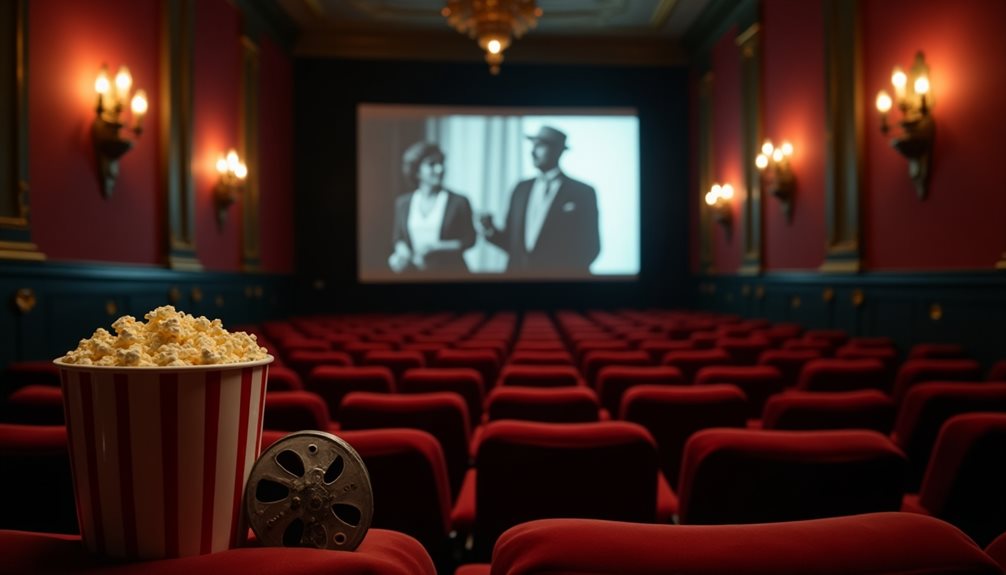Understanding the vocabulary of Russian cinema is essential for a deeper appreciation of its artistic expression. Terms like mise-en-scène and cinematography reveal the craftsmanship behind film narratives. In addition, exploring character archetypes and themes provides insight into the cultural and philosophical undercurrents present in these works. As one navigates the complexities of Russian films, the significance of language and context becomes increasingly evident, prompting further exploration into this fascinating cinematic landscape.
Table of Contents
ToggleEssential Film Terminology

Essential film terminology serves as the foundation for understanding the intricate language of cinema, particularly within the context of Russian film. Familiarity with terms such as mise-en-scène, cinematography, and editing is vital for effective film analysis.
These concepts illuminate the cinematic techniques employed by directors to convey themes and emotions, offering deeper insight into the narrative structure. For instance, the use of long takes can evoke a sense of realism, while dramatic lighting may enhance tension.
Understanding core film terminology is crucial for anyone studying cinema, and it becomes even more valuable when exploring Russian film. Recognizing these terms in both English and Russian not only aids in analysis but also deepens appreciation for Russian cinematic traditions and history.
Below, you’ll find key concepts explained, along with a practical table of essential Russian vocabulary related to film studies. This approach helps bridge the gap between English and Russian film analysis, making it easier to follow discussions, read criticism, or participate in classes focused on Russian cinema.
Character Archetypes in Russian Cinema
Although character archetypes in Russian cinema may initially seem familiar, they often embody complex nuances that reflect the country’s rich cultural and historical fabric. Central to this cinematic landscape are heroic figures and tragic villains, each representing deeper societal themes and struggles. Heroic figures often symbolize resilience and moral clarity, while tragic villains manifest the consequences of despair and moral ambiguity.
Heroic Figures (Герой / geroi)
In Russian cinema, the heroic figure is more than just a protagonist or a fighter for justice. This character often faces tremendous adversity—sometimes from the state, sometimes from society, and sometimes from within. The Russian hero tends to embody:
- Resilience: Persistence in the face of hardship.
- Moral Integrity: A strong sense of right and wrong, even when it comes at a personal cost.
- Sacrifice: Willingness to give up personal happiness or safety for a greater good.
Example:
In the film “Ballad of a Soldier” (Баллада о солдате), the young soldier Alyosha travels across war-torn Russia to see his mother, helping strangers along the way, demonstrating selflessness and compassion.
Tragic Villains (Трагический злодей / tragicheskiy zlodey)
Tragic villains in Russian cinema often evoke sympathy. Their actions may be harmful or destructive, but they are shaped by circumstances, personal failures, and broader societal issues. These characters illustrate:
- Complexity: They are rarely purely evil; their motivations are layered.
- Flaws: Personal weaknesses, moral conflicts.
- Societal Reflection: Often represent failures or contradictions within society.
Example:
In “Brother” (Брат), antagonists are not simply “bad guys” but products of post-Soviet disarray, poverty, and lost values.
Related Russian Terms
| Russian (Cyrillic) | Phonetic | English Definition |
|---|---|---|
| Герой | geroi | Hero |
| Злодей | zlodey | Villain |
| Жертва | zhertva | Sacrifice / Victim |
| Сопротивление | soprotivleniye | Resistance |
| Совесть | sovest’ | Conscience |
| Трагедия | tragediya | Tragedy |
| Судьба | sud’ba | Fate |
| Страдание | stradaniye | Suffering |
| Свобода | svoboda | Freedom |
| Идентичность | identichnost’ | Identity |
Russian cinema uses these archetypes not only to tell stories but also to invite viewers to reflect on larger questions about freedom, identity, and the resilience of the human spirit. Understanding these character types—and the language used to describe them—enriches both cultural appreciation and language learning.

Key Themes Explored in Russian Films
While exploring the rich fabric of Russian cinema, one encounters a myriad of themes that resonate deeply with the human experience. Central to this cinematic landscape are historical narratives that reflect the tumultuous past of Russia, from wars to revolutions.
These narratives serve not merely as backdrops but as catalysts for profound examination of societal struggles. Filmmakers often investigate the complexities of identity, morality, and the quest for freedom, revealing the intricacies of human resilience amidst oppression.
The struggles depicted in these films resonate with audiences, invoking a collective empathy for the characters’ plights. Ultimately, Russian cinema invites viewers to reflect on their own societal contexts, encouraging a dialogue about the enduring pursuit of freedom and understanding in a fractured world.
Russian cinema is known for its depth, emotional power, and exploration of universal themes.
- Historical Narratives: Russian films frequently revisit significant historical events such as the October Revolution, World War II (Великая Отечественная война), and the Stalinist era. Examples include Come and See (Иди и смотри) and Burnt by the Sun (Утомлённые солнцем).
- Societal Struggles: Many films depict the challenges faced by ordinary people during times of social upheaval, exploring poverty, political repression, and survival. Films like The Cranes Are Flying (Летят журавли) highlight personal stories set against national crises.
- Identity and Morality: Characters in Russian cinema often grapple with questions of right and wrong, personal duty versus collective responsibility, and the search for meaning. Leviathan (Левиафан) examines corruption and moral compromise.
- Freedom and Oppression: The tension between authority and the individual is a recurring motif. The Thief (Вор) and Repentance (Покаяние) showcase personal resistance against oppressive systems.
- Resilience and Endurance: Human strength in the face of adversity is central to many stories, reflecting the Russian concept of “выстоять” (to endure). Ballad of a Soldier (Баллада о солдате) beautifully illustrates this theme.
Useful Russian Terms Related to Film
| Russian (Cyrillic) | English Phonetic | English Definition |
|---|---|---|
| история | istoriya | history |
| война | voyna | war |
| революция | revolyutsiya | revolution |
| свобода | svoboda | freedom |
| идентичность | identichnost’ | identity |
| мораль | moral’ | morality |
| сопротивление | soprotivleniye | resistance |
| трагедия | tragediya | tragedy |
| герой | geroi | hero |
| общество | obshchestvo | society |
| борьба | bor’ba | struggle/fight |
| угнетение | ugneteniye | oppression |
| надежда | nadezhda | hope |
| судьба | sud’ba | fate/destiny |
| выживание | vyzhivaniye | survival |
Learning these terms can help you discuss Russian films in their original context and deepen your understanding of both the language and the powerful stories told in Russian cinema.
Iconic Directors and Their Styles
As Russian cinema has evolved, it has been shaped by a cadre of iconic directors whose unique styles and visions have left an indelible mark on the medium.
Two of the most iconic figures in Russian filmmaking are Sergei Eisenstein and Andrei Tarkovsky, each with a style that has shaped film history.
Eisenstein’s use of montage and Tarkovsky’s focus on spiritual introspection exemplify their distinct directorial trademarks, making their films both revolutionary and contemplative.
Their mastery of visual language transcends mere entertainment, inviting audiences to engage with profound philosophical questions.
Sergei Eisenstein
Eisenstein is famous for developing the technique of montage—the art of editing separate shots to create new meaning. His films, such as Battleship Potemkin (Бронено́сец «Потёмкин»), use fast-paced editing to build tension and emotion. Montage became a cornerstone of cinematic storytelling around the world.
Example:
- In the famous “Odessa Steps” sequence from Battleship Potemkin, quick cuts between the fleeing crowd and soldiers’ boots intensify the horror and chaos.
Andrei Tarkovsky
Tarkovsky is known for his poetic and spiritual approach. His films, like Stalker (Ста́лкер) and Solaris (Солярис), feature long takes, slow pacing, and rich symbolism. Tarkovsky often explores philosophical questions about life, faith, and memory, inviting viewers to reflect deeply.
Example:
- In Stalker, Tarkovsky uses lingering shots of nature and decaying buildings to create a meditative mood.
Other Influential Russian Directors
- Dziga Vertov (Дзига Вертов) – experimental documentaries, “Kino-Eye” theory
- Nikita Mikhalkov (Никита Михалков) – blending personal stories with historical events
- Aleksei German (Алексей Герман) – bleak realism and historical drama
Key Russian Film Terms
| Russian (Cyrillic) | English Phonetic | English Definition |
|---|---|---|
| режиссёр | re-zhis-SOR | director |
| монтаж | mon-TAZH | montage (editing technique) |
| символизм | sim-vo-LIZM | symbolism |
| кадр | KAdr | film shot/frame |
| сцена | STSENA | scene |
| повествование | po-vest-vo-VA-nie | narration/storytelling |
| оператор | o-pe-ra-TOR | cameraman/cinematographer |
| сценарий | stse-NA-riy | screenplay |
| философия | fi-lo-SO-fi-ya | philosophy |
| искусство | is-KUS-stvo | art |
| фильм | FILM | film/movie |
| зритель | ZRI-tyel | viewer/audience |
Learning these terms can help you better understand Russian discussions about cinema and appreciate the cultural context behind these legendary directors’ works.
Notable Russian Film Genres
Russian cinema encompasses a diverse array of genres, each reflecting the cultural, historical, and social intricacies of the nation. Among these, Soviet realism stands out, portraying the life and struggles of the common people during turbulent times. This genre not only served propaganda purposes but also offered a raw, unvarnished glimpse into societal challenges.
Conversely, psychological thrillers have emerged as a compelling genre, delving into the complexities of the human psyche. These films often explore themes of paranoia, identity, and moral ambiguity, resonating with audiences seeking deeper narratives.
Together, these genres highlight the versatility of Russian cinema, inviting viewers to engage with both the stark realities of life and the labyrinthine depths of the human experience, ultimately celebrating the quest for freedom.
![]()
Советский реализм (Soviet Realism)
Soviet realism, or социалистический реализм (socialist realism), was the dominant style in Soviet cinema from the 1930s. Films in this genre focused on ordinary people’s lives, often highlighting workers, soldiers, or collective farmers overcoming hardship for the greater good.
Notable films:
- “Броненосец Потёмкин” (Battleship Potemkin)
- “Летят журавли” (The Cranes Are Flying)
Психологический триллер (Psychological Thriller)
Psychological thrillers in Russian cinema often explore the mind’s depths, focusing on characters’ moral dilemmas and internal conflicts. These films can be intense and thought-provoking.
Notable films:
- “Солярис” (Solaris) by Andrei Tarkovsky
- “Груз 200” (Cargo 200)
Военный фильм (War Film)
War films are a significant genre in Russian cinema, reflecting the country’s turbulent history, especially World War II (Великая Отечественная война).
Notable films:
- “Иди и смотри” (Come and See)
- “Они сражались за Родину” (They Fought for Their Motherland)
Комедия (Comedy)
Russian comedies often include elements of satire and irony, both gentle and biting, reflecting everyday life and absurdities.
Notable films:
- “Ирония судьбы, или С лёгким паром!” (The Irony of Fate)
- “Бриллиантовая рука” (The Diamond Arm)
Драма (Drama)
Dramas focus on deep emotional conflicts and personal stories, sometimes touching on social issues or family dynamics.
Notable films:
- “Левиафан” (Leviathan)
- “Кукушка” (The Cuckoo)
Related Russian Terms
| Русский термин | Phonetic | English Definition |
|---|---|---|
| Жанр | zhanr | Genre |
| Фильм | feelm | Film |
| Советский реализм | savyetskiy re-alizm | Soviet realism |
| Социалистический реализм | sotsialisticheskiy re-alizm | Socialist realism |
| Психологический триллер | psikhologicheskiy treeler | Psychological thriller |
| Военный фильм | va-yen-nyy feelm | War film |
| Драма | drama | Drama |
| Комедия | ka-mye-di-ya | Comedy |
| Режиссёр | re-zhi-syor | Director |
| Актёр / Актриса | ak-tyor / ak-tree-sa | Actor / Actress |
| Сценарий | stse-nar-ee | Script/Screenplay |
| Кинематограф | kee-neema-tograf | Cinematography |
| Съёмки | syom-ki | Filming |
Language and Dialogue in Russian Movies

Russian films captivate audiences through their masterful linguistic tapestry, where dialogue transcends mere plot devices to become portals into cultural identity and human psychology. The interplay of words reveals intricate character motivations while exposing broader societal truths—from unspoken emotional currents to national historical consciousness.
For language learners, these cinematic exchanges offer unparalleled immersion, showcasing authentic speech patterns ranging from casual interactions to heightened dramatic discourse. Beyond vocabulary acquisition, viewers gain insight into how linguistic subtleties shape relationships, convey unspoken norms, and reflect Russia’s evolving sociopolitical landscape. This dual role—as both narrative engine and cultural mirror—makes dialogue analysis essential for understanding the full depth of Russian storytelling artistry.
The Power of Dialogue
Russian film dialogue often contains layers of meaning, subtle humor, and regional expressions. Understanding these features can deepen your appreciation of both the language and the story.
1. Language Nuances in Russian Film Dialogue
Forms of Address
- Вы vs. ты: The formal (вы) and informal (ты) “you” can signal distance or closeness.
- Patronymics: Using names like “Иван Иванович” (Ivan Ivanovich) shows respect, especially in formal settings or when addressing elders.
Colloquialisms & Real-Life Speech
Russian films are filled with everyday phrases, slang, and humor that textbooks rarely cover. For example:
- Ну давай! (Come on!)
- Ладно, пошли. (Okay, let’s go.)
Intonation
A phrase like “Ты пришёл?” (“You came?”) can express surprise, disappointment, or happiness depending on tone.
2. Dialogue Analysis
Subtext
Characters may say:
- Всё нормально. (“It’s fine.”)
But the context or body language may suggest the opposite.
Interruptions & Pauses
Pauses often hint at discomfort or hidden tension. For instance:
- Я… ну, я не знаю… (“I… well, I don’t know…”)
Repetition
Repeating words or phrases can emphasize emotion:
- Ну ты посмотри, посмотри! (“Just look at that, look!”)
![]()
![]()
3. Cultural Reflections
Societal Values
Themes like family and loyalty are common. Dialogue might include:
- Семья — это главное. (“Family is the most important thing.”)
Conflicts
Generational misunderstandings often appear:
- Вы меня не понимаете. (“You don’t understand me.”)
![]()
![]()
4. Emotional Weight
Understatement
Much is left unsaid. Silence can be powerful.
Expressive Outbursts
When emotions do erupt, dialogue becomes intense:
- Хватит! (“Enough!”)
![]()
![]()
Related Russian Terms in Film Dialogue
| Русский | Phonetic | English Definition |
|---|---|---|
| Ты / Вы | ty / vy | informal/formal “you” |
| Здравствуйте | Zdravstvuyte | Hello (formal) |
| Привет | Privet | Hi (informal) |
| Пожалуйста | Pozhaluysta | Please/You’re welcome |
| Спасибо | Spasibo | Thank you |
| До свидания | Do svidaniya | Goodbye |
| Как дела? | Kak dela? | How are you? |
| Всё нормально | Vsyo normal’no | It’s fine/Everything’s okay |
| Ладно | Ladno | Alright/Okay |
| Давай | Davay | Come on/Let’s go |
| Семья | Sem’ya | Family |
| Друзья | Druz’ya | Friends |
| Любовь | Lyubov’ | Love |
| Уважение | Uvazheniye | Respect |
| Хватит! | Khvatit! | Enough! |
Russian movies bring the language to life, showing not just what Russians say, but how and why they say it. Watching these films with an ear for dialogue helps learners deeply understand both language and culture.
Cultural References and Context in Russian Cinema
Russian cinema presents a vibrant mosaic of cultural references that deepen its stories and themes. These films reflect the country’s complex history, capturing both the challenges and achievements of its people. Motifs from folklore, literature, and politics are woven throughout, adding layers of meaning to the narratives.
Symbolism serves an important role—not just in developing characters, but also in prompting viewers to reflect on societal issues. Recognizing these references reveals the values and conflicts that have shaped Russian identity over time.
For English speakers learning Russian, exploring these cultural details enhances both language skills and cultural understanding. Below are some key themes in Russian cinema, along with useful Russian terms.
Key Themes in Russian Cinema
1. Folklore and Mythology
Russian filmmakers often draw on traditional tales and legends, infusing movies with archetypal characters and symbolic motifs. For example, the character of Баба Яга (Baba Yaga) appears in both children’s films and more serious works as a symbol of mystery or danger.
2. Literature Adaptations
Many classic Russian films are based on works by authors like Dostoevsky, Tolstoy, or Chekhov. These adaptations often preserve the original philosophical questions and moral dilemmas, such as the conflict between individual freedom and social responsibility.
3. Political and Historical Symbolism
Soviet-era cinema frequently used allegory to comment on censorship, power, and resistance. Films like Броненосец Потёмкин (Battleship Potemkin) or Андрей Рублёв (Andrei Rublev) reflect struggles for freedom and resilience.
4. Everyday Life and Social Commentary
Post-Soviet films often portray the complexities of daily life, focusing on themes like family ties, economic hardship, and generational change.
Useful Russian Terms in Cinema
| Русский (Cyrillic) | English Phonetic | English Definition |
|---|---|---|
| Культура | kultura | culture |
| Символ | simvol | symbol |
| Фольклор | folklor | folklore |
| Литература | literatura | literature |
| Свобода | svoboda | freedom |
| История | istoriya | history |
| Герой | geroi | hero/character |
| Образ | obraz | image/character archetype |
| Советский Союз | Sovetskiy Soyuz | Soviet Union |
| Реальность | real’nost’ | reality |
| Традиция | traditsiya | tradition |
| Режиссёр | rezhissyor | director |
| Сценарий | stsenariy | script/screenplay |
| Народ | narod | people/nation |
| Драма | drama | drama |
Examples of Cultural References in Popular Russian Films
- “Брат” (Brat/Brother) – Explores post-Soviet identity and the search for meaning after the collapse of the USSR.
- “Ирония судьбы” (Ironiya sud’by/The Irony of Fate) – A beloved New Year’s film filled with jokes and references to everyday Soviet life.
- “Сталкер” (Stalker) – Uses science fiction to discuss philosophical questions about hope and destiny, referencing both Soviet experience and universal human concerns.
Russian Cinema: Interesting Statistics
| Category | Statistic / Fact |
|---|---|
| Film Production | Over 7,000 films produced in Russia/former Soviet Union since early 20th century |
| Annual Film Output | Russia produces approximately 100–120 feature films per year |
| Global Reach | Russian films are screened in over 90 countries, subtitled in dozens of languages |
| International Recognition | Battleship Potemkin ranked 11th greatest film in Sight & Sound’s 2012 critics’ poll |
| Leviathan (2014) nominated for Academy Award, won Golden Globe in 2015 | |
| The Cranes Are Flying (1957) is the only Russian-language film to win the Palme d’Or at Cannes | |
| Audience / Box Office | Over 30 million tickets sold for Russian films in 2023 |
| Irony of Fate has over 250 million cumulative viewers since release | |
| Broadcast Tradition | Irony of Fate is broadcast annually on New Year’s Eve |
| Genres and Trends | Soviet realism accounted for over 60% of domestic releases (1930–1960) |
| Drama and psychological thriller genres grew by over 40% in production share post-Soviet era | |
| Festivals | Moscow International Film Festival established in 1935 |
| Receives over 1,500 film submissions annually from more than 80 countries | |
| Language Learning | Watching Russian films with subtitles increases vocabulary retention by 30% compared to textbook learning |
| Famous Figures | Sergei Eisenstein’s montage technique referenced in over 100 academic publications |
| Andrei Tarkovsky’s Stalker cited as influence by more than 50 international directors |
Frequently Asked Questions
What Are the Most Influential Russian Films of All Time?
The most influential Russian films encompass Soviet classics like “Battleship Potemkin” and contemporary masterpieces such as “Leviathan.” Each work profoundly reflects societal struggles, offering insights that resonate with audiences yearning for freedom and artistic expression.
How Can I Watch Russian Films With English Subtitles?
To watch Russian films with English subtitles, one should explore various streaming platforms that offer diverse subtitle options. This approach not only enhances understanding but also enriches the viewer’s appreciation of cinematic artistry across cultures.
What Are the Major Film Festivals in Russia?
The major film festivals in Russia, particularly the Moscow International Film Festival and the Sochi Open, showcase diverse cinematic talents. These events provide platforms for artistic expression, fostering cultural dialogue and celebrating the spirit of freedom in filmmaking.
How Has Russian Cinema Evolved Over the Decades?
Russian cinema has undergone significant evolution, shifting from the ideologically driven narratives of the Soviet Era to more diverse, expressive storytelling in the Post-Soviet Shift, reflecting a broader quest for artistic freedom and cultural identity.
Which Actors Are Most Recognized in Russian Cinema?
In Russian cinema, top actors like Oleg Menshikov and Chulpan Khamatova are celebrated for their iconic performances. Their ability to convey profound emotions reflects the complexity of Russian culture, resonating deeply with audiences seeking artistic freedom and expression.



